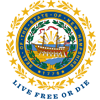Surface Water Quality
Evaluating and monitoring surface water PFAS concentrations.
Ambient surface water quality is governed under RSA 485-A:1-22 and Administrative rule Env-Wq 1700, collectively making up the surface water quality standards under the Clean Water Act. The surface water quality standards consist of three parts: designated uses, such as fishing or swimming; numerical or narrative criteria to protect the designated uses; and an antidegradation policy, which maintains existing high quality water that exceeds the criteria. NHDES convenes the informal Water Quality Standards Information Exchange to facilitate public input, solicit advice and provide a forum for the discussion of focused surface water quality standards issues.
A great deal of scientific research goes into setting water quality criteria. To help states, and create a level of national consistency, EPA typically provides recommendations to states in the form of National Recommended Water Quality Criteria 304(a) Guidance for ambient surface water conditions. Presently, there is no EPA 304(a) guidance for PFAS compounds, and NHDES has never created a surface water criterion for toxics. Full surface water quality standards for PFAS could yield nine different criteria for each PFAS compound depending upon:
- The end-point to be protected (human health or aquatic life health).
- The route of exposure (water consumption, tissue consumption or both).
- The criteria type (acute or chronic for aquatic life health).
In December 2019, NHDES produced a Plan to Generate PFAS Surface Water Quality Standards, prepared for the New Hampshire Legislature in Accordance with Chapter 368, Laws of 2018, that contains a schedule and cost estimates were the State to generate its own criteria, as well as a wealth of information on data needs for standard development and implementation and the impacts to different segments of the state.
A number of site-specific projects have evaluated surface water PFAS concentrations and in 2017 NHDES sampled the 40 trend monitoring sites that are used to track the long-term water quality changes in a broad range of watersheds with varying sizes and land use characteristics as part of the Water Monitoring Strategy. The 2017 sampling is summarized in Section 4.3 of the aforementioned Plan to Generate PFAS Surface Water Quality Standards. The full range of surface water PFAS sampling can be seen by selecting layers on the NHDES PFAS Sampling Map and ensuring the only layer selected is "Surface Water Sample."
Fish Consumption Advisories
Consumption of fish and shellfish is one of the potentially direct impacts of PFAS in surface waters to New Hampshire residents. NHDES funded a fish tissue study in 2020 resulting in the report PFAS Baseline Study of Lake Fish Specimen, Surface Water, and Sediment in Multiple Lakes, New Hampshire. The data from that report was used by the department’s Environmental Health Bureau to issue new fish consumption advisories for five lakes in Southern New Hampshire in November 2021.



